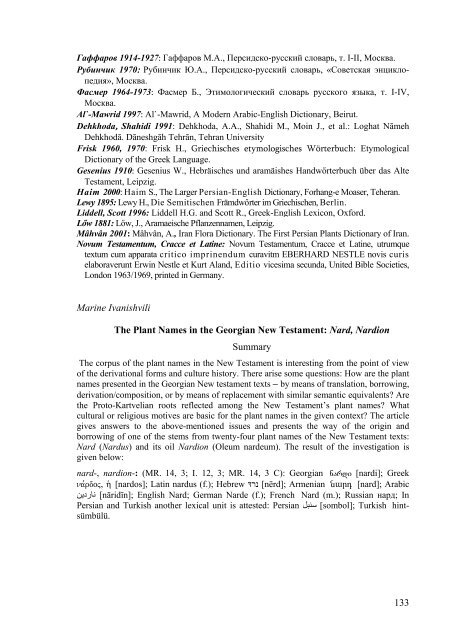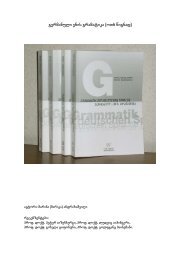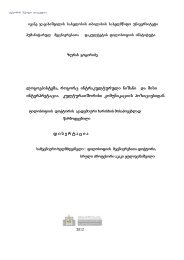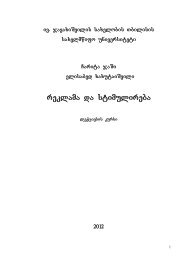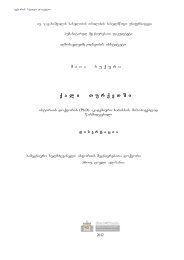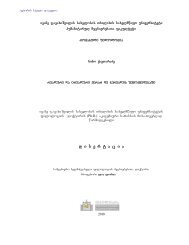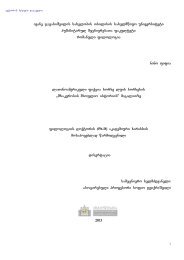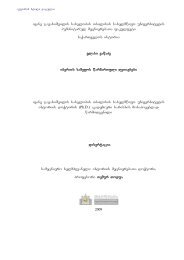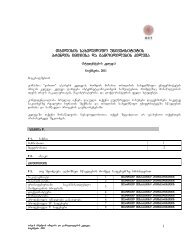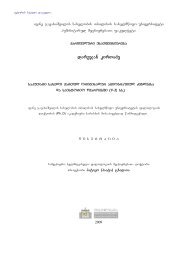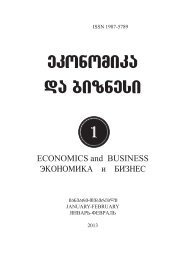issues of linguistics - Tbilisi State University
issues of linguistics - Tbilisi State University
issues of linguistics - Tbilisi State University
Create successful ePaper yourself
Turn your PDF publications into a flip-book with our unique Google optimized e-Paper software.
Гаффаров 1914-1927: Гаффаров М.А., Персидско-русский словарь, т. I-II, Москва.<br />
Рубинчик 1970: Рубинчик Ю.А., Персидско-русский словарь, «Советская энциклопедия»,<br />
Москва.<br />
Фасмер 1964-1973: Фасмер Б., Этимологический словарь русского языка, т. I-IV,<br />
Москва.<br />
Al`-Mawrid 1997: Al`-Mawrid, A Modern Arabic-English Dictionary, Beirut.<br />
Dehkhoda, Shahidi 1991: Dehkhoda, A.A., Shahidi M., Moin J., et al.: Loghat Nāmeh<br />
Dehkhodā. Dāneshgāh Tehrān, Tehran <strong>University</strong><br />
Frisk 1960, 1970: Frisk H., Griechisches etymologisches Wörterbuch: Etymological<br />
Dictionary <strong>of</strong> the Greek Language.<br />
Gesenius 1910: Gesenius W., Hebräisches und aramäishes Handwőrterbuch über das Alte<br />
Testament, Leipzig.<br />
Haim 2000: Haim S., The Larger Persian-English Dictionary, Forhang-e Moaser, Teheran.<br />
Lewy 1895: Lewy H., Die Semitischen Främdwőrter im Griechischen, Berlin.<br />
Liddell, Scott 1996: Liddell H.G. and Scott R., Greek-English Lexicon, Oxford.<br />
Lőw 1881: Lőw, J., Aramaeische Pflanzennamen, Leipzig.<br />
Mâhvân 2001: Mâhvân, A., Iran Flora Dictionary. The First Persian Plants Dictionary <strong>of</strong> Iran.<br />
Novum Testamentum, Cracce et Latine: Novum Testamentum, Cracce et Latine, utrumque<br />
textum cum apparata critico imprinendum curavitm EBERHARD NESTLE novis curis<br />
elaboraverunt Erwin Nestle et Kurt Aland, Editio vicesima secunda, United Bible Societies,<br />
London 1963/1969, printed in Germany.<br />
Marine Ivanishvili<br />
The Plant Names in the Georgian New Testament: Nard, Nardion<br />
Summary<br />
The corpus <strong>of</strong> the plant names in the New Testament is interesting from the point <strong>of</strong> view<br />
<strong>of</strong> the derivational forms and culture history. There arise some questions: How are the plant<br />
names presented in the Georgian New testament texts _ by means <strong>of</strong> translation, borrowing,<br />
derivation/composition, or by means <strong>of</strong> replacement with similar semantic equivalents? Are<br />
the Proto-Kartvelian roots reflected among the New Testament’s plant names? What<br />
cultural or religious motives are basic for the plant names in the given context? The article<br />
gives answers to the above-mentioned <strong>issues</strong> and presents the way <strong>of</strong> the origin and<br />
borrowing <strong>of</strong> one <strong>of</strong> the stems from twenty-four plant names <strong>of</strong> the New Testament texts:<br />
Nard (Nardus) and its oil Nardion (Oleum nardeum). The result <strong>of</strong> the investigation is<br />
given below:<br />
nard-, nardion-: (MR. 14, 3; I. 12, 3; MR. 14, 3 C): Georgian nardi [nardi]; Greek<br />
na,rdoj, ¹ [nardos]; Latin nardus (f.); Hebrew דּ רנ [nērd]; Armenian ݳñ¹ [nard]; Arabic<br />
ﻦﻳدرﺎﻧ [nāridīn]; English Nard; German Narde (f.); French Nard (m.); Russian нард; In<br />
Persian and Turkish another lexical unit is attested: Persian ﻞﺒﻨﺳ [sombol]; Turkish hintsümbülü.<br />
133


